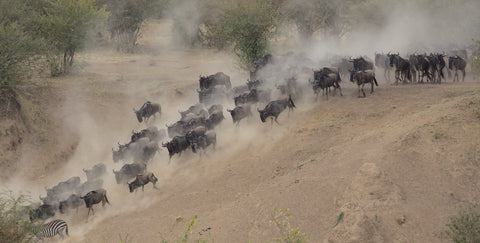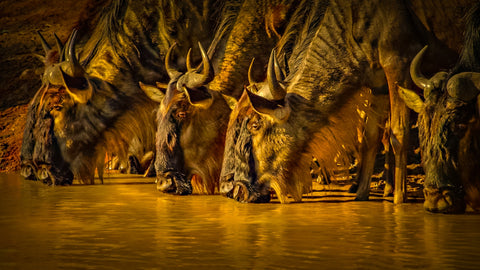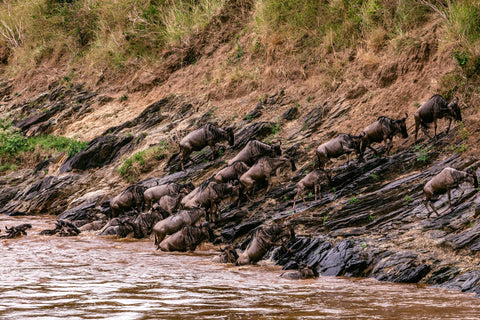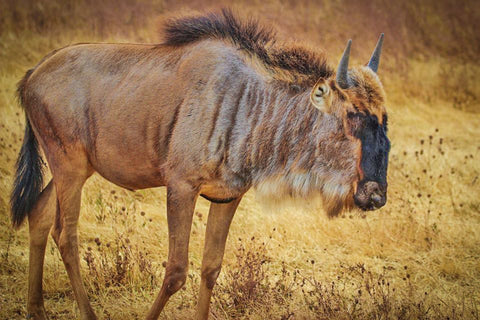What is the Great wildebeest migration?

Why is the The Great Wildebeest Migration captivating?

What month is the great wildebeest migration?
While the migration is a remarkable spectacle, it does come with inherent dangers. The animals must navigate long distances, face potential predators such as lions and crocodiles, and overcome obstacles like rivers and unpredictable weather conditions. These challenges contribute to the dramatic nature of the migration.
Which countries does the wildebeest migration take place? Kenya and Tanzania in East Africa. How many wildebeests cross over between Kenya and Tanzania? Over 1.5 Million wildebeests.
Watch our amazing video of the wildebeest migration on our YouTube channel.
What are some facts about the Great wildebeest migration?
The Great Wildebeest Migration is one of the most remarkable natural events that takes place in East Africa, primarily between Kenya and Tanzania. It involves the movement of millions of wildebeests, along with other herbivores such as zebras and gazelles, in search of fresh grazing lands and water sources. Here's an overview of this incredible migration:
Route and Timing:
The migration is a circular movement that occurs throughout the year, but its most renowned and dramatic phase happens between the Serengeti National Park in Tanzania and the Maasai Mara National Reserve in Kenya. The exact timing can vary, but typically, the wildebeest migration starts in the southern Serengeti around January and reaches the Maasai Mara by July or August. The animals then return to the Serengeti around October, completing the cycle.
Animal Numbers:
The migration involves an astonishing number of animals. It is estimated that over 1.5 million wildebeests, hundreds of thousands of zebras, and other herbivores participate in this journey. The wildebeests dominate the scene and their numbers create a breathtaking sight as they move in massive herds across the plains.
Reasons for Migration:
The primary driving force behind the migration is the search for fresh grazing and water. As the dry season progresses and the grass in one area gets depleted, the herds move to regions with greener pastures and better water sources. They follow the rainfall patterns, which influence the availability of vegetation.
Challenges and Obstacles:
The wildebeests face numerous challenges during their migration. They encounter predators such as lions, hyenas, cheetahs, and crocodiles while crossing rivers, which can result in the loss of many individuals. Additionally, exhaustion, starvation, and injuries also take a toll on the weaker members of the herds.
River Crossings:
One of the most awe-inspiring and dangerous aspects of the migration is the river crossings, most notably across the Mara River. Here, the wildebeests must traverse treacherous waters infested with crocodiles. They gather in large numbers at the riverbanks, building up courage before plunging into the river, often causing chaotic scenes. Many individuals are lost to drowning or predation during these crossings.

Ecological Significance:
The migration has a profound ecological impact on the savannah ecosystem. The grazing patterns of the wildebeests help maintain the balance between grass and other vegetation, preventing any single area from being overgrazed. Their manure enriches the soil, and their carcasses provide sustenance to scavengers and aid in nutrient cycling.
Tourist Attraction:
The Great Wildebeest Migration is a major draw for tourists from around the world. It is considered one of the world's most spectacular wildlife events and provides an opportunity to witness the raw power of nature. Safaris, guided tours, and hot air balloon rides are popular ways to experience the migration up close.
The Great Wildebeest Migration is a true marvel of the natural world. It showcases the resilience and determination of these animals as they face various challenges during their epic journey across the East African plains.
Is the great migration worth it? Absolutely!
The Great Migration, referring to the annual movement of wildebeest and other herbivores in East Africa, is widely considered one of the most incredible wildlife spectacles on the planet. Whether it is worth experiencing depends on your personal interests, preferences, and priorities. Here are some factors to consider:
Natural Wonder: Witnessing the Great Migration is a remarkable natural phenomenon that showcases the awe-inspiring power of nature. It involves millions of animals on the move, crossing rivers, and navigating the vast landscapes of the Serengeti-Mara ecosystem. If you have a deep appreciation for wildlife and the natural world, witnessing the migration can be a profoundly rewarding experience.
Unique Sights and Sounds: The migration offers unique sights and sounds that are etched in memory. Seeing massive herds of wildebeest stretching across the plains, accompanied by zebras and gazelles, creates a sense of awe and wonder. The thundering hooves, the dust clouds, and the calls of the animals all contribute to an unforgettable sensory experience.
Wildlife Viewing: The migration attracts a variety of predators, such as lions, cheetahs, leopards, and crocodiles, who take advantage of the abundant prey. This creates exceptional opportunities for wildlife viewing and witnessing predator-prey interactions. If you're passionate about wildlife photography or observing animals in their natural habitat, the Great Migration can provide remarkable photo opportunities.
Timing and Planning: The migration occurs in a cyclical pattern, and timing is crucial to witness the most significant events, such as river crossings. It's important to plan your visit during the appropriate season and choose the right locations to increase your chances of witnessing key moments of the migration. Research and guidance from experienced guides or tour operators can help ensure a successful experience.
Crowds and Costs: The Great Migration is a popular attraction, and certain periods can draw a considerable number of tourists. This means that some areas might be crowded during peak times. Additionally, visiting the migration can involve significant costs, including transportation, accommodation, park fees, and guide services. Considering your budget and tolerance for crowds is essential when evaluating the overall worth of the experience.

Ultimately, whether the Great Migration is worth it depends on your individual interests, love for wildlife, and the value you place on witnessing remarkable natural events. If you have the opportunity and resources, it can be a once-in-a-lifetime adventure that offers incredible insights into the natural world.

